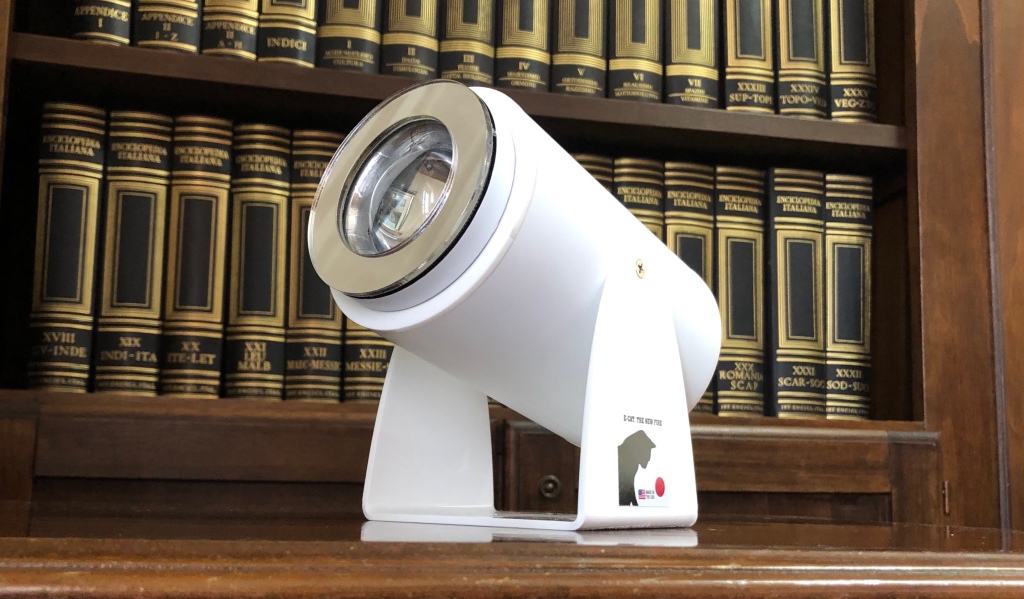

Today, on December 9, 2021, Leonardo Corporation made a presentation of two Ecat based products—the lamp Ecat SKLed and the power source Ecat SKLep. The presentation had the form of a 14 minutes video, giving a brief view of the products and their characteristics, and also showing a short demonstration of the performance.
After the video presentation, a live Q&A session was held, and both products can now be pre-ordered, without payment, at USD25 and USD249 respectively, with delivery only if the total number of pre-orders arrives at 1 million.
The claimed performance of the products is revolutionary, to say the least.
The Ecat SKLed supposedly has a luminous flux of 10,000 lumens, consuming only about 4W, giving it a luminous efficacy of about 2,500 lumens per watt, or roughly 25 times better than standard LED lamps.
10,000 lumens is a strong light, usable for lighting up large indoor and outdoor spaces.
The Ecat SKLep is claimed to produce an electric output power of 100W at the voltage 12V DC, consuming only 1W, meaning a 100x gain. The 1W input can be provided by a battery at 12VDC, making the power source portable. It has a volume of less than half a liter and a weight of 250 grams.
100 watts would power a TV-set, but a continuous power production of 100W could do more. Four or five units would cover the electricity consumption of an average household in the EU, and three units the average electricity consumption of an electric car.
Both products are carbon-free with no emissions, they have an expected lifetime of 100,000 hours and neither of them consumes any fuel. According to the hypothesis presented in a paper by Andrea Rossi, the energy released derives from a quantum-based phenomenon called Zero Point Energy.
Obviously, a video demonstration cannot prove any of these claims.
Earlier this year, the Ecat inventor Andrea Rossi stated that by the time of the presentation, the Ecat SKLed would be certified for safety and performance by a global certification company. Later, he included also the Ecat SKLep.
I was happy to note his pledge, since a thorough and extended evaluation of the performance of the Ecat technology by a recognized certification company had never been done before. And I have been in contact with him over the last months to get an insight of the certification results.
However, measurements on the lamp Ecat SKLed that were presented at the demonstration don’t support the claim of 10,000 lumens at all, while a solid verification over a long period of the power source Ecat SKLep is still missing. This is the situation:
- A verification made by a global certification company exists. It is very extensive and has been performed over about six months, but contrary to what Andrea Rossi stated earlier this year, this certification regards only safety, not performance. I know of no other certification of the new Ecat products.
- A measurement report from the University of Bologna on the lamp Ecat SKLed was published at the presentation. Those who have read the report may have noted that the measured illuminance (in lux) at three different distances doesn’t support the claimed luminous flux of 10,000 lumens at all. Since illuminance (lux) is luminous flux (lumens) per area, the luminous flux (lumen) is easily calculated, multiplying the illuminance in lux by the area that the light cone penetrates at the distance where the illuminance is measured. All necessary values for this calculation are available in the report. The result is that the luminous flux from the lamp doesn’t exceed 500 lumens, even when using the illuminance from the brightest part of the light cone. This means that the lamp has a luminous efficacy of about 100 lumens/watt, which is a normal value for a standard LED lamp, and far from the claimed 2,500 lumens/watt. This is also confirmed by the measurements made in the video presentation on December 9, 2021.
- Two measurement reports from the University of Bologna on the power source Ecat SKLep were also published (here and here). These reports do support the claim of a 100W electric power production at a 1W power consumption, meaning a 100x power gain. The measurement were performed over a period of six hours, meaning an energy production of 600 Wh or 2,400 Wh/kg, which exceeds the specific energy for the most advanced batteries on the horizon by far (and with the claim of 100,000 hours expected operational time the difference compared to batteries will obviously be huge). But given the revolutionary claims, I would prefer to see further third-party verifications, over days or months, to confirm these findings and to exclude any error or mistake.
There is a general lack of transparency regarding the verifications which may be understandable during the R&D phase, but which is unacceptable when you start offering products for sale. Repeatedly through the years, I and other persons have not been allowed to freely make measurements on various kinds of Ecat based devices, with the excuse that some measurements would reveal industrial secrets.
However, to perform a solid third-party verification, and to make it accessible in a transparent way is not difficult, even if you want to protect the intellectual property. It should be made by an established certification company over several days, and not by a single person but by at least two or three people in a team.
Only the inventor Andrea Rossi can make this happen. Until he does, there is still reason to have doubts about the efficiency end performance of the products, particularly given the measurement report by the University of Bologna showing that the claims for the lamp Ecat SKLed are not supported.
This is unfortunate.
The world is in urgent need of a new, clean energy source. Through the years since 1989, hundreds of documented experiments have demonstrated thermal energy release from another field involving atomic particle interaction, often clustered using the term LENR, Low Energy Nuclear Reactions. This is also the field where Andrea Rossi initially thought the explanation of his technology could be found.
In recent years, the activity in this field has increased. A recognised theory is still lacking, but energy release far beyond levels from chemical reactions, without radiation and without emissions, have been observed in series of experiments by several groups.
Companies such as Brillouin Energy, Brilliant Light Power, and Aureon Energy (SAFIRE project) are continuing their efforts to understand the reaction and to create a sustainable small-scale and clean energy source from it.
And individuals and non-profit groups such as the Martin Fleischmann Memorial Project are working hard to investigate and replicate experiments in the field with the mission to spread it to the public on an open-science basis.
Andrea Rossi may have something along these lines with his Ecat technology. There have been several experiments and measurements on earlier versions of his technology, clearly demonstrating a thermal energy release. I have personally done some of these measurements myself.
But for selling products, he will need to present a solid and transparent verification of the current electricity-producing Ecat technology, which is still missing.